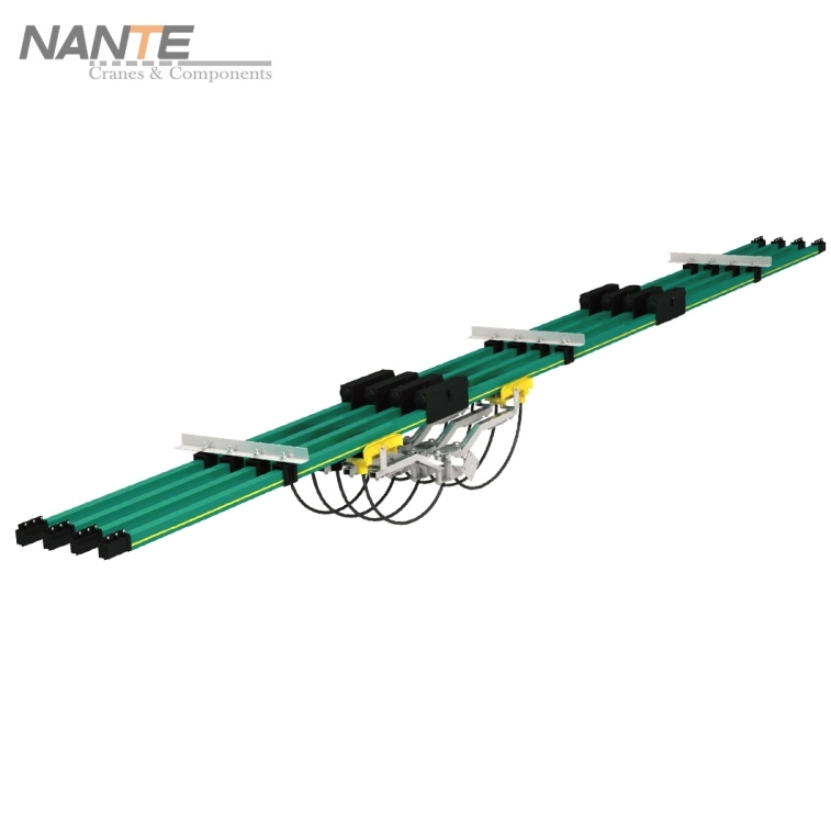How to Select the Right Crane Conductor Rail System for Your Needs
Date: 2025-04-08 Share:
What Are Crane Conductor Rail Systems?
Crane conductor rail systems are systems of power supply for mobile cranes. They consist of rails supplying power along the crane’s path of travel to facilitate continuous, smooth operation. A typical crane conductor rail system consists of conductors, connectors, collectors, and insulation materials. Crane conductor rail systems are used in factories, warehouses, shipyards, and other industrial environments. The power conductor rail system is a lifeline to the crane, providing it with the power needed to operate.
Why Proper Selection is Important for Crane Efficiency
Accurate choice of a crane conductor rail system is crucial to effective and safe crane operation. A poorly matched system can cause power losses, overheating, or even unsafe short circuits. With the correct conductor rail system, you can have assured constant power, reduced maintenance needs, and increased equipment longevity. Safety also improves as you protect personnel and assets. A correctly selected power conductor rail system avoids your crane from incurring costly downtimes and ensures that your crane is running where and when it should be.
Key Components of a Power Conductor Rail System
Every crane conductor rail system has several basic parts. The rail itself carries the electrical current and is usually made of aluminum or copper. Collector assemblies move with the crane and draw power from the rails. These collectors are usually mounted on arms and have carbon brushes or contact shoes that touch the rail. Insulation is another important part, which keeps the system safe and helps prevent shocks or short circuits. Finally, mounting hardware secures everything in place, ensuring that the crane conductor rail is aligned and properly spaced for operation.
Step 1: Evaluate Your Crane System Type and Layout
Monorail vs. Bridge vs. Runway Systems
Different crane setups require different power supply systems. Monorails have a single beam and are best for straight-line travel. Bridge cranes have two parallel runways and a moving bridge, while runway systems support overhead cranes across larger spaces. Each type changes how the crane conductor rail system must be designed and installed. For example, a bridge crane may need conductor rails on both runways, while a monorail system might only need one. Understanding your crane layout helps ensure that the power conductor rail system fits perfectly with minimal power loss.
Measuring Run Length and Travel Path
Accurate measurement is key. You need to know how far your crane will travel to decide how long the conductor rails must be. This also includes considering how the rails will be spaced and where the power feed will come from. Long travel paths may need multiple power feed points or thicker rails to avoid voltage drops. Carefully measuring the crane’s full path ensures your crane conductor rail can deliver reliable power throughout its entire movement.
Step 2: Assess Electrical and Operational Demands
Voltage, Current, and Power Feed Requirements
Power needs vary depending on the crane. Some cranes work with 230V, others with 480V or more. You must match the voltage of the crane to the conductor rail system. The current load, or how much electricity the crane draws during operation, is also important. A crane that lifts heavy materials often needs more current. The power conductor rail system should be strong enough to handle these loads without overheating. A mismatch can cause serious electrical issues.
Duty Cycle and Number of Cranes
Duty cycle refers to how often the crane runs. Some cranes operate all day, while others only work for a few minutes per hour. Continuous-use cranes require more durable conductor rails. If you have more than one crane using the same conductor rail, you must calculate their total current demand. The crane conductor rail must support all cranes without overloading. This is especially important in factories where multiple cranes move together.
Step 3: Factor in Environmental Conditions
Indoor vs. Outdoor Environments
Where your crane operates matters. Indoor environments are usually dry and protected, while outdoor cranes face rain, dust, and temperature changes. For outdoor use, conductor rails must be weatherproof. Moisture and dust can damage power connections or cause rust. Choosing crane conductor rail systems that are sealed or treated for weather protection is important in harsh outdoor environments.
Temperature and Corrosion Resistance
In hot or freezing conditions, the material of the conductor rail becomes crucial. Copper conducts electricity well and resists corrosion, making it a good choice for tough environments. Aluminum is lighter and cheaper, but it may need extra coatings. In places with salty air or chemicals, corrosion-resistant materials help the system last longer. A power conductor rail system built for extreme environments can run reliably for many years.
Step 4: Choose the Right Conductor Rail Type
Nante Unipole Conductor Rail
Nante Unipole Conductor Rail is perfect for simple installations. If your crane has moderate power needs and works in a stable environment, this rail is a cost-effective solution. It is easy to install and maintain, making it popular in smaller factories or workshops.
Nante High Tro Reel Conductor Rail (Seamless Power Rail)
Nante High Tro Reel Conductor Rail (Seamless Power Rail) is flexible and can bend to fit complex layouts. It delivers continuous power without breaks, which is great for cranes that follow curves or have long travel paths. It is also ideal when power interruptions are unacceptable. This seamless power rail is designed for smooth and steady current flow in complicated crane paths.
Nante Enclosed Conductor Rail
Safety is the top feature here. Nante Enclosed Conductor Rail is built with extra insulation and protection, making it perfect for high-risk areas. If your crane works in a hazardous environment, such as near chemicals or high heat, this conductor rail offers peace of mind and strong safety performance.
Step 5: Installation and Safety Considerations
Mounting Methods and Spacing Guidelines
The way you install the crane conductor rail affects how well it works. You can mount it overhead, on the side, or on the floor, depending on the crane type. Each method has its own spacing needs. Rails must be aligned correctly to prevent collector wear or power loss. Poor mounting can lead to broken parts or accidents.
Compliance with Safety Standards (ECMA 35, OSHA 1910.179)
Following safety rules is a must. ECMA 35 and OSHA 1910.179 give guidelines on voltage limits, insulation levels, and safe installation. Using crane conductor rail systems that meet these standards helps protect workers and equipment. It also ensures that your system passes inspections.
Why Choose Nante Crane Conductor Rail Systems?
Custom Solutions for Unique Needs
Nante understands that every site is different. That’s why they offer custom solutions with a wide range of conductor options. Whether you need aluminum or copper, custom colors, or special mounting setups, Nante can deliver a crane conductor rail system that fits perfectly with your site and power needs.
Durability and Performance Advantages
Nante’s systems are built to last. They have high conductivity, which means better power flow and less energy loss. Their systems are also low-maintenance, thanks to durable materials and smart design. Choosing Nante means you get reliable performance every day with fewer repairs.
5 FAQs About Crane Conductor Rail Systems
How do you pick a crane rail size?
You should base the size on your crane’s current load, voltage, and how far it travels.
What are the different types of crane rails?
Enclosed rails, H-beam systems, and V-contact rails are among the most common types.
What are the electrical standards for cranes?
Standards like ECMA 35 and OSHA 1910.179 help make sure your crane systems are safe and effective.
How do I choose a crane capacity?
Look at your crane’s heaviest expected load, and add a safety buffer of around 20–25%.
Can one power conductor rail system support multiple cranes?
Yes, but you must check that the total power demand does not exceed what the system can handle.
Whether you’re upgrading an indoor monorail or designing a rugged outdoor runway, Nante’s Unipole Conductor Rail, High Tro Reel Conductor Rail (seamless power rail), and Enclosed Conductor Rail are engineered to keep your operations smooth and safe. Struggling to calculate voltage requirements or rail spacing? Let our experts simplify it for you! Email us today for a free consultation, and we’ll help you build a system that’s as reliable as your cranes.






